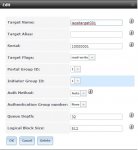Dear,
Recently I noticed we have the message that our ZFS volume is reaching its capacity.
Our current setup: 10x4TB drives in a RAIDZ-2 configuration with ZFS on top.
Hardware: E3-1230 with 8GB RAM
We mainly want to use freenas as an iscsi target device for our other equipment which will store bunch of data. Cause of a limitation on the vendor side we have to create multiple volumes of 1.5T on the ZFS volume and then map them in iscsi.
So I have configured 16x1.5T volumes in our ZFS volume and have thus 24TB of storage available and thus roughly 8TB free storage left.
As ZFS uses additional storage we incalculated the additional 20% of 24TB=4.8TB of reserved space which is below the 8TB that is already available.
Forva long time the 8TB free space was not used but recently I noticed that the free storage was dropping till 2TB today and thus giving the message that only 91% of storage is available for ZFS.
Now i'm afraid that the 2TB remaining will not be sufficient although we reserved roughly 33% additional storage but the result will be that our storage will be full and everything will stop working.
So anyone an idea why ZFS keeps on growing and what we can do to avoid?
Recently I noticed we have the message that our ZFS volume is reaching its capacity.
Our current setup: 10x4TB drives in a RAIDZ-2 configuration with ZFS on top.
Hardware: E3-1230 with 8GB RAM
We mainly want to use freenas as an iscsi target device for our other equipment which will store bunch of data. Cause of a limitation on the vendor side we have to create multiple volumes of 1.5T on the ZFS volume and then map them in iscsi.
So I have configured 16x1.5T volumes in our ZFS volume and have thus 24TB of storage available and thus roughly 8TB free storage left.
As ZFS uses additional storage we incalculated the additional 20% of 24TB=4.8TB of reserved space which is below the 8TB that is already available.
Forva long time the 8TB free space was not used but recently I noticed that the free storage was dropping till 2TB today and thus giving the message that only 91% of storage is available for ZFS.
Now i'm afraid that the 2TB remaining will not be sufficient although we reserved roughly 33% additional storage but the result will be that our storage will be full and everything will stop working.
So anyone an idea why ZFS keeps on growing and what we can do to avoid?

